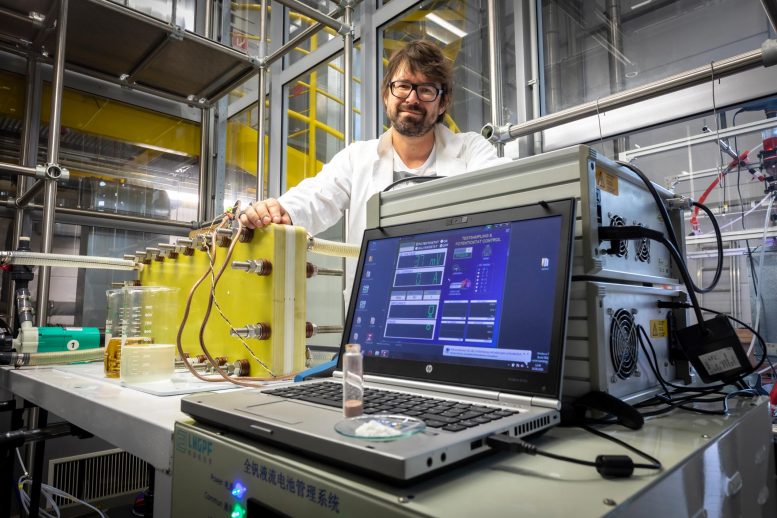
TU Graz researcher Stefan Spirk has found a way to replace liquid electrolytes in redox flow batteries with vanillin. Credit: © Lunghammer – TU Graz
Researchers at TU Graz have found a way to convert the aromatic substance vanillin into a redox-active electrolyte material for liquid batteries. The technology is an important step towards ecologically sustainable energy storage.
It is ground-breaking in the field of sustainable energy storage technology,” says Stefan Spirk from the Institute of Bioproducts and Paper Technology at Graz University of Technology. He and his team have succeeded in making redox-flow batteries more environmentally friendly by replacing their core element, the liquid electrolyte, which are mostly made up of ecologically harmful heavy metals or rare earths – with vanillin, an important ingredient of Austrian vanilla croissants.
Sustainable energy storage
Vanillin, a commonly used flavor compound, is one of the few fine-chemicals produced is obtained from lignin. International research teams and companies have already proven that lignin is potentially suitable as a starting material for the production of electrolytes.
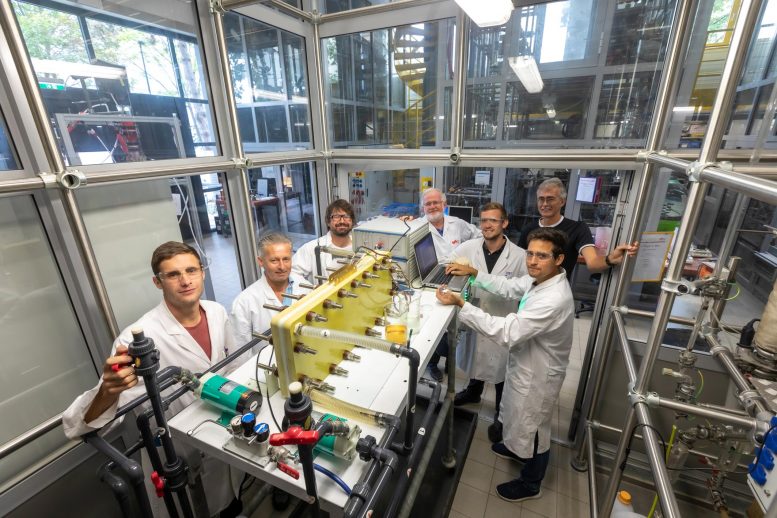
Want to commercialise the “green” redox flow technology developed at Graz University of Technology: Dominik Wickenhauser, Dieter Wurm, Stefan Spirk, Wolfgang Bauer, Georg Rudelstorfer, Werner Schlemmer und Wolfgang Zitz (f. l.). Credit: © Lunghammer – TU Graz
Spirk and his team go one step further: “We refine lignin into vanillin into a redox-active material using mild and green chemistry without the use of toxic and expensive metal catalysts, so that it can be used in flow batteries.” The process works at room temperature and can be implemented with common household chemicals. Vanillin is also present in large quantities. “On the one hand, we can buy it quite conventionally, even in the supermarket, but on the other hand we can also use a simple reaction to separate it from lignin, which in turn is produced in large quantities as waste product in paper production.”
Patenting and commercialization
The separation and refining process was patented and the successful test results were published in the journal Angewandte Chemie. Now the researchers want to commercialize the technology, especially since the process is highly scalable and suitable for continuous production. Spirk explains: “The plan is to hook up our plant to a pulp mill and isolate the vanillin from the lignin that is left over as waste. Whatever is not needed can subsequently flow back into the regular cycle and be used energetically as usual. We are in concrete talks with Mondi AG, a leading global manufacturer of paper-based products, which is showing great interest in the technology.”
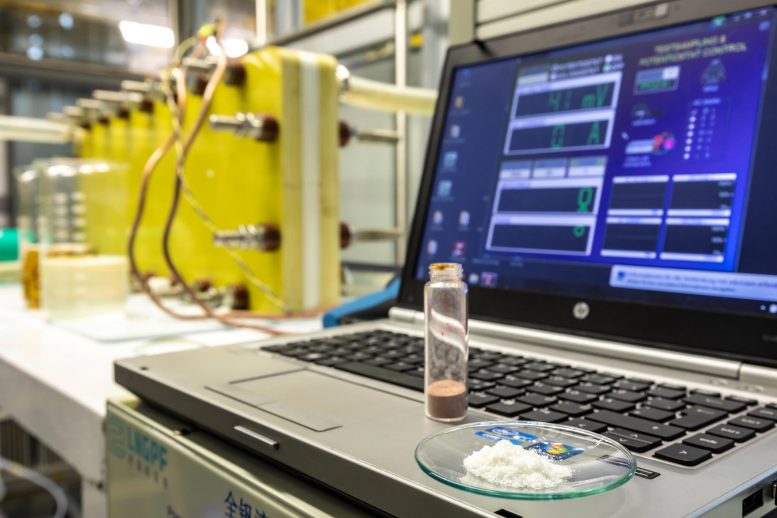
Tests at TU Graz with a 3 kilowatt hour prototype and with vanillin-based electrolytes proved the effectiveness of the new process. Credit: © Lunghammer – TU Graz
For the final implementation, the technology has to be tested in real operation. The company is now looking for energy supply companies that can integrate the start-up’s redox flow technology into its infrastructure and thus relieve the burden on the grid. Spirk is convinced of its future success because: “We can keep the value chain ranging from the procurement of raw materials and components to the generation of electricity on a regional basis, enable storage capacities of up to 800 hundreds of MWhmegawatt hours, relieve the strain on the electricity grid and make an important contribution to the green energy storage. revolution.”
Liquid battery as a piece of the jigsaw puzzle for the energy revolution
Redox flow technology is an important piece of the puzzle for the expansion of renewable energies such as wind and solar power, as it is characterized by the storage of large amounts of energy and can therefore cushion voltage peaks in the power grid. The batteries are also suitable as backup storage for stationary applications such as power plants, hospitals, mobile phone systems or e-fuelling stations. Redox flow batteries are more easily scalable, less toxic, more recyclable and more fireproof than lithium-ion batteries. Other major advantages are their high life expectancy and low self-discharge.
Reference: “2‐Methoxyhydroquinone from Vanillin for Aqueous Redox‐Flow Batteries” by Werner Schlemmer, Dr. Philipp Nothdurft, Alina Petzold, Prof. Gisbert Riess, Philipp Frühwirt, Dr. Max Schmallegger, Prof. Georg Gescheidt‐Demner, Prof. Roland Fischer, Prof. Stefan A. Freunberger, Prof. Wolfgang Kern and Prof. Stefan Spirk, 20 August 2020, Angewadte Chemie International Edition.
DOI: 10.1002/anie.202008253
This research work is anchored in the Fields of Expertise “Sustainable systems” and “Advanced materials science”, two of the five strategic research foci of Graz University of Technology.
The work was part of the research project “Lignobatt – Lignin in Redox-Flow Batteries”, which was funded by the Climate and Energy Fund and carried out within the framework of the “Energy Research Programme 2016 – Emerging Technologies” of the Austrian Research Promotion Agency FFG. Project partners at Graz University of Technology were the Institute of Bioproducts and Paper Technology, the Institute of Chemistry and Technology of Materials, and the Institute of Physical and Theoretical Chemistry. The team received external support from the Chair of Materials Science and Testing of Polymers at Montanuniversität Leoben and from the Mondi company.






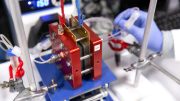

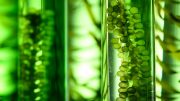
Be the first to comment on "Ecological Power Storage Battery Made of Vanillin, the Main Flavor Component of Vanilla"